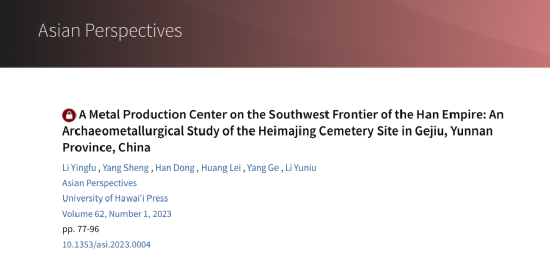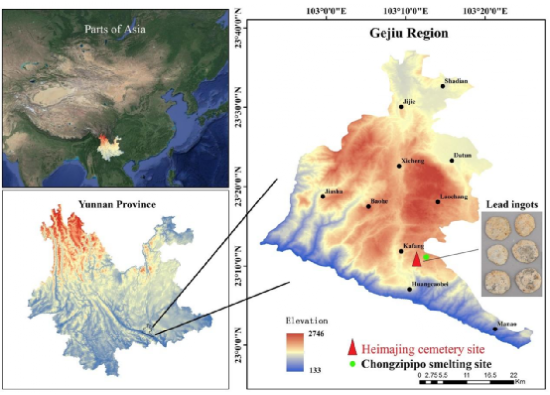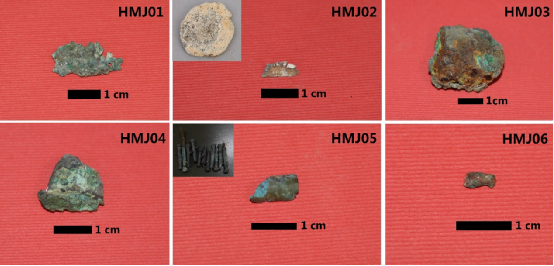The latest academic achievements of the archaeometallurgy team have been published in an international journal.

The team of the National Social Science Fund Major Project 鈥淚nvestigation and Research on Metallurgical Sites in the Pre-Qin and Han Dynasties in Southwest China鈥� led by Professor Li Yingfu from the Center for Archaeological Science, Sichuan University, in carrying out the special study of 鈥淢etallurgical Technology in the Pre-Qin and Han Dynasties in Southwest China鈥�, interpreted the production supply chain relationship between the primary products of copper and lead metals in the Qin and Han Dynasties in Southwest China and the Indochina Peninsula with a broad vision and multidisciplinary methods. The latest academic achievement, 鈥淎 Metal Production Center on the Southwest Frontier of the Han Empire: an archaeometallurgical study of the Heimajing cemetery site in Gejiu, Yunnan, China鈥�, has been published in Asian Perspectives: The Journal of Archaeology for Asia and the Pacific. Professor Li Yingfu is the first author of the paper, doctoral student Yang Sheng is the second author, Dr. Han Dong is the third author, and Associate Professor Li Yuniu is the corresponding author of the paper. Yang Ge and Huang Lei from Gejiu City Museum provided important assistance for sampling and analysis and are co-authors of the paper.
Through the data analysis of lead isotope ratios, this achievement found that there is a clear production supply chain relationship between the ore producing areas in Southwest China and the unearthed metal cultural relics in the Indochina Peninsula. There is cross-regional circulation of bronze raw materials and products between the two places on at least three interactive channels: western Yunnan and northern Thailand, southeastern Yunnan and northern Vietnam, and western Guizhou and central Cambodia. This discovery shows that before the Qin and Han dynasties' management system entered the region, there was already a complex supply relationship of bronze raw materials between many bronze cultures in Southwest China and the Indochina Peninsula, and a wide-ranging and long-distance bronze product trade and exchange network had been formed.
The results of copper and lead scientific and technological analysis show that the lead isotope ratio data of smelting remains unearthed from the Heimajing Cemetery in Gejiu, Yunnan, are related to the lead isotope ratio data of bronzes and lead wares unearthed from the Tao Sheng, Dong Xa, and Dinh Xa sites in northern Vietnam. Among them, the ore characteristic data of the lead knife unearthed from the Dong Xa site and the lead ingot unearthed from the Heimajing Cemetery are basically the same, and the bronzes unearthed from this site also contain more than 1% arsenic. Most of the bronzes unearthed from the Tao Sheng and Dinh Xa sites have lead isotope ratios close to those of the artifacts unearthed from the Heimajing Cemetery. The area where the Tao Sheng, Dong Xa, and Dinh Xa sites are located was in Jiaozhi County during the Han Dynasty. During the Han Dynasty, Gejiu area could conveniently communicate with the Jiaozhi County area through river network channels. Therefore, the metal products produced in the Heimajing area of Gejiu are very likely to have circulated to the Jiaozhi County area (now northern Vietnam). The theory, methods, and results of this study are important explorations for carrying out cross-regional archaeological research in Southwest China and Southeast Asia.
The Heimajing Cemetery is located in Heimajing Village, southeast of Kafang Town, Gejiu City, Yunnan (Figure 1). The cemetery was first discovered in 1988. Four archaeological excavations were carried out in 1989, 1994, 1995, and 2010, and a total of 43 Han tombs were cleared, and a large number of exquisite bronze wares (Figure 2), porcelain, and pottery were unearthed, which are important materials for studying the history and social life of the Han Dynasty in Yunnan Province. Some scholars have judged that the age range of the Heimajing Cemetery is from the late Western Han Dynasty to the Xin Mang period based on the tomb shape, unearthed relics, and a large number of Han Dynasty coins.

Figure 1. Location of Heimajing Cemetery

Figure 2. Part of the bronzes unearthed from Heimajing Cemetery
Smelting remains such as lead ingots and copper blocks were unearthed from five tombs, M15, M28, M31, M34, and M43, excavated in 2010 (Figure 3). The analysis results show that sample HMJ03 contains a small amount of irregular copper particles and gangue composed of iron, calcium, and other elements carried in the ore, and the main components are iron silicate and calcium silicate. Sample HMJ06 contains 99% copper and is waste formed during copper casting; sample HMJ01 is a Cu-Pb eutectic alloy, which is a mixture of lead and copper materials; sample HMJ04 is a Cu-As-Pb alloy; sample HMJ05 (bronze arrow bracket) is a Cu-Sn-Pb-As alloy; sample HMJ02 should be a locally produced lead ingot.

Figure 3. Smelting-related relics unearthed from Heimajing Cemetery
